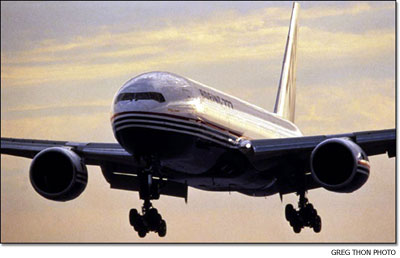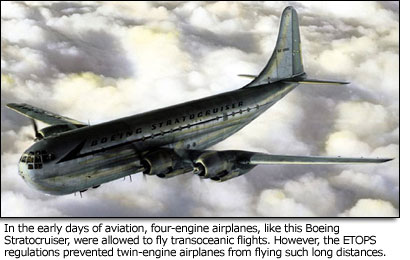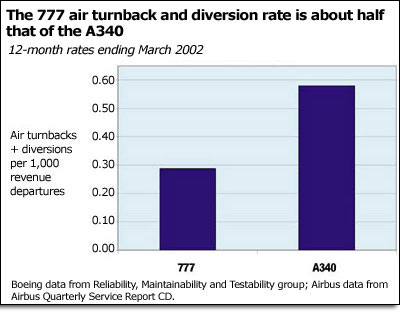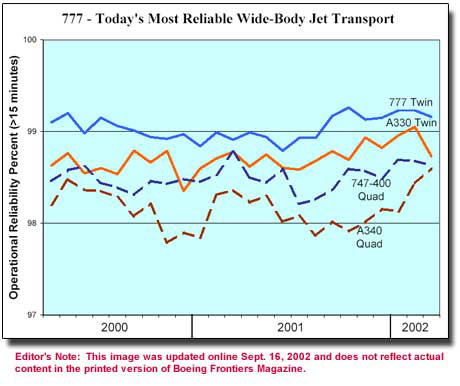| An Airbus advertising campaign at the
Farnborough Air Show stoked the fires in the debate between ... Two
engines & four engines
BY KATHLEEN HANSER

 Two engines versus four engines was a hot topic in media reports from
July's Farnborough, England, Air Show, where Airbus stirred the debate
with a colossal billboard at the edge of a runway that read, "A340 —
4 engines 4 long haul." Similar full-page ads appeared in air show magazines
and daily London newspapers.
Two engines versus four engines was a hot topic in media reports from
July's Farnborough, England, Air Show, where Airbus stirred the debate
with a colossal billboard at the edge of a runway that read, "A340 —
4 engines 4 long haul." Similar full-page ads appeared in air show magazines
and daily London newspapers.
While Airbus officials argued that the ads were not about safety, the
prevailing opinion of industry experts at the show was exactly the opposite — the
ads were meant to suggest that twinjets, such as the Boeing 767 and 777,
were not as safe or reliable as four-engine airplanes, namely the Airbus
A340, the closest competitor to the market-leading 777.
Airplane engine manufacturers were among those in the industry voicing
their disapproval of the ads run at Farnborough.
"We are vehemently opposed to what Airbus is doing here,"
said David Calhoun, president and chief executive of General Electric's
GE Aircraft Engines to The Wall Street Journal. "An ad
like that is the last thing this industry needs right now."
In the same article, a Pratt & Whitney spokesman commented, "Twin-engine
airplanes are every bit as safe as four-engine airplanes."
At issue is extended operations (ETOPS), which means twin-engine aircraft
meeting certain criteria are allowed to fly long-distance routes that,
in some cases, can take them up to three hours away from the nearest airport.
In the event of an engine failure, all airplanes are required to divert
to the nearest suitable alternate airport. However, if a four-engine jet
loses one engine, it is allowed to continue to its original destination
if safety is not compromised.
As the Farnborough media reports were quick to note, this was not the
first time Airbus had created controversy with its advertising strategy.
In 1999, Airbus released and then pulled from circulation an ad that conveyed
a similar theme. That ad showed an A340 flying over a vast, stormy ocean,
with a caption stating, "If you're over the middle of the
Pacific, you want to be in the middle of four engines."
A firestorm of negative reaction from customers and other industry organizations
led Airbus to stop running the ad.
Boeing's reaction
Nicole Piasecki, vice president of Marketing and Business Strategy at
Boeing Commercial Airplanes, saw it this way: "It seems intellectually
dishonest for Airbus to make statements like this, when there are many
airlines flying two-engine A310 and A330 airplanes over the Atlantic.
The four-engine A340 has not sold nearly as well as the twin-engine 777.
This ad strategy appears to be an attempt to boost sales by playing on
unsubstantiated fears, and we don't believe playing on public fears has
any place in advertising."
 Since
the twin-engine 777 was introduced in 1995, the Boeing jetliner has outsold
its Airbus competitors by a wide margin, capturing nearly 70 percent of
the market. There are 30 airlines worldwide operating 777s. Since
the twin-engine 777 was introduced in 1995, the Boeing jetliner has outsold
its Airbus competitors by a wide margin, capturing nearly 70 percent of
the market. There are 30 airlines worldwide operating 777s.
Piasecki also pointed out that Airbus has long been a proponent and beneficiary
of twin-engine ETOPS. A 1992 Airbus Industrie ETOPS brochure stated:
"The operation of Airbus twin-engine aircraft under ETOPS regulations
is a commonplace phenomenon in the four corners of the globe.
"The passengers also benefit from ETOPS on those long routes between
city pairs where the traffic would not be economically viable for larger
aircraft but could be supported by a smaller twin."
The debate
According to proponents of four-engine jets, if a twinjet loses one engine,
the airplane and passengers could get stranded at an alternate airport
that is remote and inhospitable, where there are no decent airport, food
or lodging facilities. On the other hand, a four-engine jet could, if
it met certain stringent safety guidelines, continue to its destination.
But as Boeing Commercial Airplanes Vice President of Marketing Randy
Baseler pointed out, "Don't fall for this four-engine stuff.
If an engine goes out on any airplane, many times the safest option is
to land at the nearest airport rather than continue.
"Think of it this way," Baseler said. "If you have
two engines, there are two chances of engine failure. If you have four
engines, there are four chances of engine failure. The chance of engine
malfunction doesn't go down with four engines; it goes up."
It also is important to note that more than 90 percent of airplane diversions
have nothing to do with engines but rather involve weather, a sick passenger
or other reasons, Baseler said.
"We believe the issue is really about getting passengers where
they want to go in the most reliable way," Baseler said. "And
reliability is one of the main reasons so many of the world's major
airlines choose the 777."
According to Baseler, records for the four-engine A340 show it has had
twice as many diversions and turnbacks as the twin-engine 777, and the
A340 has a lower average dispatch reliability rate than the 777.
Proven reliability with lower costs
 In
some three million ETOPS flights logged since 1985, no twinjet has ever
been lost during the ETOPS portion of the flight, which is the portion
when the airplane is farthest from an alternate airport. More than 1,000
ETOPS flights take off every day. The Boeing 777 has had only one diversion
for inflight engine shutdown during the ETOPS portion out of over 300,000
flights in the past seven years. In
some three million ETOPS flights logged since 1985, no twinjet has ever
been lost during the ETOPS portion of the flight, which is the portion
when the airplane is farthest from an alternate airport. More than 1,000
ETOPS flights take off every day. The Boeing 777 has had only one diversion
for inflight engine shutdown during the ETOPS portion out of over 300,000
flights in the past seven years.
"Obviously, we have proven that twin-jet long-haul flights can
be done — and done safely — so why waste precious resources by
adding two engines that aren't needed?" said Baseler. "In
the case of the A340-600, those two extra engines add a 20 percent higher
fuel burn per passenger over the 777-300ER."
In sales campaigns between the 777 and the A340, Boeing can point out
the larger 777-300ER has 18 percent lower operating costs per passenger
than the A340-600 on the same route.
"As an airline operator, you would prefer the 777 for its low operating
costs," said Baseler. "As a passenger, you would prefer the
777 because you have a better chance of getting where you want to go without
a diversion, a better chance of on-time departure and an award-winning,
comfortable interior."
Sir Richard Branson, whose Virgin Atlantic Airways took delivery of the
first A340-600 during the Farnborough Air Show, has said that his company's
market research shows "there was something like 17 to 18 percent
of passengers who go out of their way to fly a four-engine plane on a
long-haul flight."
But independent passenger preference surveys show that three out of four
passengers prefer the 777 over its competitors, and airlines have reported
it is easier to sell seats when a 777 is flying a route.
"One airline reported a 30-percent increase in revenue on some
routes when it flies the 777 on those routes," said Chet Ekstrand,
Boeing vice president of Regulatory Affairs.
Safety advantages
Ekstrand also pointed out that the very existence of the ETOPS program
has enhanced flying safety in general for several reasons:
• To keep their ETOPS approval, airlines are required to perform
additional maintenance and monitoring procedures on their airplanes used
for ETOPS flights.
• Boeing and other aerospace companies are challenged to make engine-reliability
improvements and aircraft-design enhancements to meet higher safety and
reliability targets.
• Airlines are required to share information routinely on the causes
of diversions and turnbacks to help identify trends in the world fleet
and reduce the recurrence of such events.
"Also, because ETOPS has made direct, non-stop flights the norm,
passengers are exposed to fewer flights, proportionately reducing their
risk," Ekstrand pointed out.
The ETOPS requirements have had a positive safety effect on airlines'
non-ETOPS fleets as well. "Having seen the benefits in their ETOPS
airplanes, many airlines choose to extend the special ETOPS-required technical
standards to their entire fleets," Ekstrand said. "They know
from experience that these simple enhancements can cut costs significantly
by reducing departure delays and in-flight engine shutdowns."
The future
 Seventeen
years of proven ETOPS flight success, coupled with even greater advancements
in engine operational safety, have paved the way for even longer point-to-point
flights. Seventeen
years of proven ETOPS flight success, coupled with even greater advancements
in engine operational safety, have paved the way for even longer point-to-point
flights.
In June 2000, the Federal Aviation Administration tasked an aviation
rulemaking advisory committee to study ETOPS requirements. The committee
is expected to make public its findings and recommendations shortly.
"Hopefully, this will set the stage for flights with even longer
diversion times in the South Pacific such as Australia to South America,"
Ekstrand said.
Boeing is determined to make sure that the traveling public does not
buy into the perception that four engines have any reliability advantage
over two-engine jets.
"We are going to be aggressive in combating misinformation about
ETOPS," Piasecki said. "It is important that passengers and
customers know the facts."
|